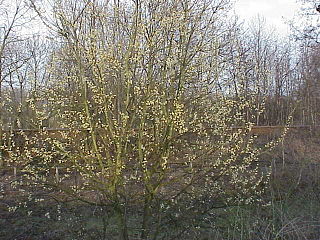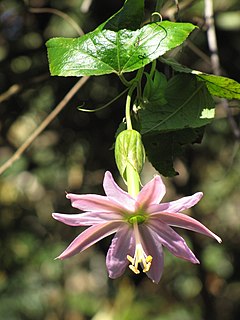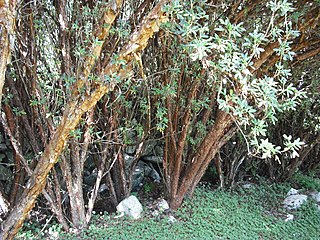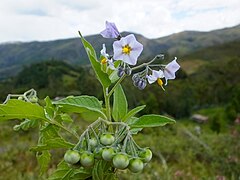
The potato is a root vegetable native to the Americas, a starchy tuber of the plant Solanum tuberosum, and the plant itself, a perennial in the family Solanaceae.

Eggplant, aubergine or brinjal is a plant species in the nightshade family Solanaceae. Solanum melongena is grown worldwide for its edible fruit.

Solanum is a large and diverse genus of flowering plants, which include three food crops of high economic importance, the potato, the tomato and the eggplant. It also contains the nightshades and horse nettles, as well as numerous plants cultivated for their ornamental flowers and fruit.

Ceratophyllum is a cosmopolitan genus of flowering plants including four accepted species in 2016, commonly found in ponds, marshes, and quiet streams in tropical and in temperate regions. It is the only genus in the family Ceratophyllaceae, itself the only family in the order Ceratophyllales. They are usually called coontails or hornworts, although hornwort is also used for unrelated plants of the division Anthocerotophyta.

The Salicaceae are a family, the willow family, of flowering plants. The traditional family included the willows, poplar, aspen, and cottonwoods. Recent genetic studies summarized by the Angiosperm Phylogeny Group (APG) have greatly expanded the circumscription of the family to contain 56 genera and about 1220 species, including the Scyphostegiaceae and many of the former Flacourtiaceae.

Alstroemeriaceae is a family of flowering plants, with 254 known species in four genera, almost entirely native to the Americas, from Central America to southern South America. One species of Luzuriaga occurs in New Zealand, and the genus Drymophila is endemic to south-eastern Australia.

The cherry tomato is a type of small round tomato believed to be an intermediate genetic admixture between wild currant-type tomatoes and domesticated garden tomatoes. Cherry tomatoes range in size from a thumbtip up to the size of a golf ball, and can range from spherical to slightly oblong in shape. Although usually red, other varieties such as yellow, green, and black also exist. Those shaped like an oblong share characteristics with plum tomatoes and are known as grape tomatoes. The cherry tomato is regarded as a botanical variety of the cultivated berry, Solanum lycopersicum var. cerasiforme.

Passiflora tarminiana is a species of passionfruit. The yellow fruits are edible and their resemblance to small, straight bananas has given it the name banana passionfruit in some countries. It is native to the uplands of tropical South America and is now cultivated in many countries. In Hawaii and New Zealand it is now considered an invasive species. It was given the name banana passionfrui in New Zealand, where passionfruit are also prevalent. In Hawaii, it is called banana poka. In its Latin American homeland, it is known as curuba, curuba de Castilla, or curuba sabanera blanca (Colombia); taxo, tacso, tagso, tauso (Ecuador); parcha, taxo (Venezuela), tumbo or curuba (Bolivia); tacso, tumbo, tumbo del norte, trompos, tintin or purpur (Peru).

Solanum sessiliflorum, the cocona, is a tropical shrub of the family Solanaceae. The cocona plant has sturdy branches and huge, serrate and hairy leaves. Cocona closely resembles a number of close relatives, including naranjilla and pseudolulo. It can be distinguished from those plants by its lack of spines. It will hybridize with those and other close relatives. Cocona also lacks the characteristic purple coloring usually seen in the naranjilla. Its flowers resemble large potato flowers, with light green petals. Cocona is harvested in parts of South America around the Amazon rainforest such as Purús Province in eastern Peru.

Solanum muricatum is a species of evergreen shrub native to South America and grown for its sweet edible fruit.

Polylepis racemosa is a species of small tree in the family Rosaceae. It is endemic to Peru, Bolivia, and Ecuador. It is threatened by habitat destruction. The International Union for Conservation of Nature has assessed the conservation status of this tree as "vulnerable".

A crop wild relative (CWR) is a wild plant closely related to a domesticated plant, whose geographic origins can be traced to regions known as Vavilov Centers. It may be a wild ancestor of the domesticated plant, or another closely related taxon.

Solanum rostratum is a species of nightshade that is native to the United States and northern and central Mexico. Common names include buffalobur nightshade, buffalo-bur, spiny nightshade, Colorado bur, Kansas thistle, bad woman, Mexican thistle, and Texas thistle.

Melaleuca orophila, commonly known as needle bottlebrush or Flinders Ranges bottlebrush, is a plant in the myrtle family, Myrtaceae and is endemic to the eastern part of South Australia.. It is a medium-sized shrub with sharp-pointed, needle-like leaves and bright red bottlebrush flower spikes.

Melaleuca faucicola commonly known as desert bottlebrush, is a plant in the myrtle family, Myrtaceae and is endemic to the Northern Territory in Australia. It is a shrub or small tree growing only in protected gorges in the ranges of Central Australia such as the Petermann Ranges and has red, cream or white spikes of flowers.

Solanum caripense is a species of evergreen shrub native to South America and grown for its edible fruit.
Solanum perlongistylum is an evergreen vine in the family Solanaceae. It is endemic to Peru, and is a close relative of S. muricatum, the domesticated pepino. Its style is the longest in the group, and its flowers have a higher pollen:ovule ratio. It is self-incompatible. It is diploid at n = 12. Together with Solanum catilliflorum, it might be an allopatric variant of S. caripense.

The Solanaceae, or nightshades, are a family of flowering plants that ranges from annual and perennial herbs to vines, lianas, epiphytes, shrubs, and trees, and includes a number of agricultural crops, medicinal plants, spices, weeds, and ornamentals. Many members of the family contain potent alkaloids, and some are highly toxic, but many—including tomatoes, potatoes, eggplant, bell and chili peppers—are used as food. The family belongs to the order Solanales, in the asterid group and class Magnoliopsida (dicotyledons). The Solanaceae consists of about 98 genera and some 2,700 species, with a great diversity of habitats, morphology and ecology.
Macrothumia kuhlmannii is a species of trees native to Bahia, Espírito Santo, and Minas Gerais states of Brazil and is the only member of the genus Macrothumia. Formerly classified in the genus Banara in the family Flacourtiaceae, phylogenetic analyses based on DNA data indicate that this species, along with its close relatives in Ahernia, Hasseltia, and Pleuranthodendron are better placed in a broadly circumscribed Salicaceae. Macrothumia differs from its close relatives in having a congested fascicle- or umbel-like inflorescence and a large fruit. The genus name is derived from the Greek word μακροθυμία, which means long-suffering and enduring patience.

Manekia is a genus of flowering plants in the family Piperaceae.

















